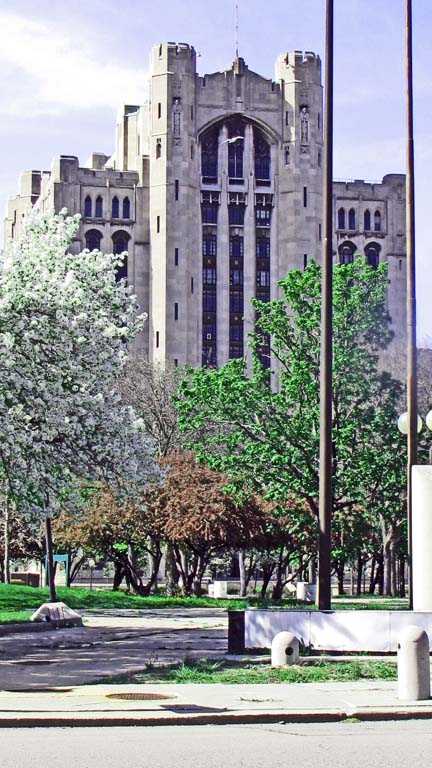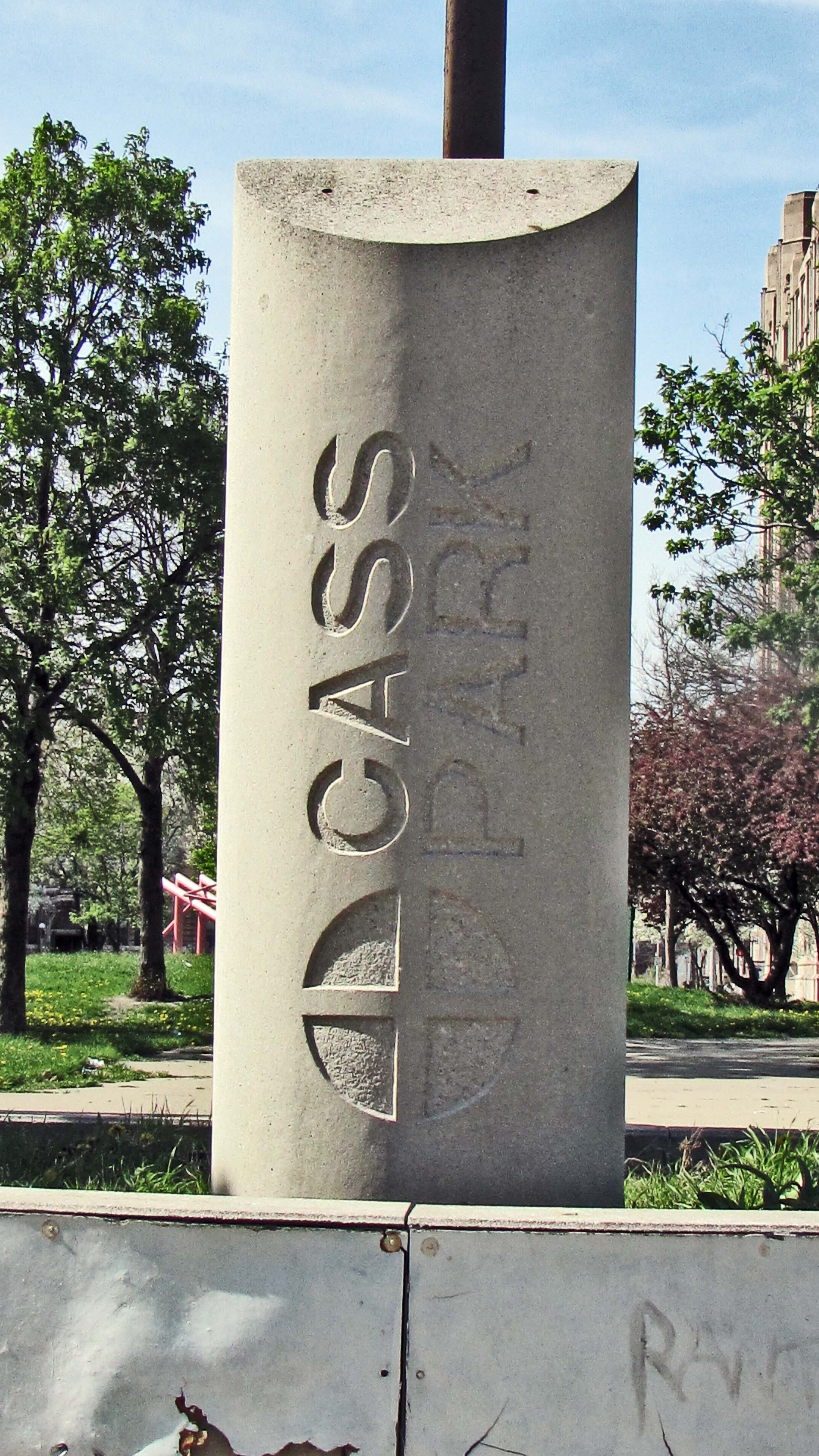


This small park has the potential to become an excellent greenspace in a renovated Detroit. However, it needs landscaping, flowers and refurbishing.
It is appropriate that the name of Lewis Cass appears in many places in Detroit and the state. Along with Father Gabriel Richard, Judge Augustus Woodward and Steven T. Mason; he made many contributions that led to the development of Michigan and gave it national prominence. It is fitting that we have Cass County, Cassopolis and the Cass River.
Lewis Cass was born in Exeter, New Hampshire in 1782 and studied at Philips Exeter Academy. In 1800, he accompanied his father who migrated to an Ohio River location, Marietta. This village, at the confluence of the Muskingum and the Ohio Rivers, was the first settlement in the Northwest Territories after the United States gained its independence from England. Cass’ father practiced law in a village that was growing rapidly as eastern settlers sailed down the Ohio to get to lands they intended to settle in the Midwest.
Lewis Cass studied the law and was admitted to the Ohio bar in 1802. Four years later he was elected to serve in the Ohio statelegislature. Then he was appointed as a federal marshal in Ohio. With the outbreak of war in 1812, he joined the military and rose to the rank of Brigadier General while leading troops in the Detroit theater, including at the crucial Battle of the Themes where the British and their Indian allies met defeat. Lewis Cass, I believe, hoped to be named by President Madison to replace General William Hull who was court marshaled for surrendering Detroit without a fight in the late summer of 1812. Hull was sentenced to death for giving up the city, but Madison stayed his execution.
In 1813, President Madison selected Lewis Cass as territorial governor, a post he held for thirteen years. William Hull was the first Territorial Governor but gave up that job to lead troops in the war that President Madison initiated against the British. As territorial governor, Cass had two great achievements. First, he minimized the Indian threat to the settlement of Michigan. Many treaties were written that sought to confine Indians to small areas within the Michigan territory. In addition, while Cass was territorial governor, Indians were very strongly encouraged to leave the state and many migrated west at this time. An historical marker at the Kalamazoo Railroad station describes the expulsion of Indians from Michigan. Cass may have been a bit more humane than other American officials in moving Indians off their historic lands so that European settlers could farm.
Second, Lewis Cass explored the Upper Peninsula and began to understand the natural resources of the state. Much has been written about the possible role he played in the Michigan territory, eventually giving up a claim to the mouth of the Maumee in return for control of what had been the northern reaches of Wisconsin. Perhaps the copper and iron in the Upper Peninsula made that a good swap for Michigan. Cass actually went on exploratory trips and assumed that his party had found the headwaters of the Mississippi River that were unknown at the time. He named a lake for himself in Minnesota; a lake he thought was the origin of the Mississippi. Cass, however, was mistaken about the origin of that river but the surveyor who accompanied him subsequently made the correct identification. This is Lake Itasca.
From 1831 to 1836, Lewis Cass served as Secretary of War in the administration of President Andrew Jackson. In that capacity, he assisted in the forceful removal of the five civilized tribes from southern states to Oklahoma. This is now known as the tragic Trail of Tears. This highly successful effort opened up lands in Georgia, Alabama and Mississippi for settlement by European Americans and fostered the growth of the cotton economy. Cass wrote about his beliefs that justified his helping to remove Indians from contact with the civilized white races was in their best interest since he presumed that they could not survive if they had to compete with whites. He also assumed, that for two centuries, missionaries had been trying to bring the benefits of Northern European civilization and Christianity to Indians. In Cass' view, the Indians rejected advanced civilization, preferring their own cultures that were, in his view, very deficient. From 1836 through 1842, Cass served his nation as Ambassador to France.
Cass sought the Democratic nomination for the presidency in 1844 but lost to James Polk who was elected president. The Michigan legislature appointed him to the United States Senate where he served from 1845 through 1848. He resigned from that body to seek the Democratic nomination for president in 1848. This time he won his party’s nomination but lost the presidential election to Zachery Taylor. The Michigan legislature once again appointed him to represent the state in the United States senate. In fact, the legislature appointed Lewis Cass to replace the vacancy caused by the resignation of Lewis Cass. He represented Michigan in the Senate until 1857 when President James Buchanan selected him to serve as Secretary of State. Cass held that appointment until late in 1860 when he resigned because of President Buchanan’s unwillingness to sufficiently prepare for the Civil War that was about to split the county.
I believe that Cass returned to Detroit at this time but his public service was over, having served as Michigan territory’s second governor, having served as the 14th and 22nd Secretary of State, two terms in the United States Senate, one term as ambassador to France and one term in the Ohio legislature.
Lewis Cass amassed property in Detroit. At one time, he owned Belle Isle. He also purchased an area that is now known as Cass Farms. It extends, approximately, from Grand River on the East to, at least, West Warren on the West. I believe the northern boundary was is now Cass Avenue and the southern boundary, perhaps, Fourth. This large area was developed for residential and commercial shortly after the Civil War; that is, shortly after the death of Lewis Cass in 1866. The park that you see pictured above was within the farm land that he owned here in Detroit
Two buildings listed on the National Historic Register face this park and, thus, are included in the Cass Park Historic District. There is the huge Masonic Temple, Zion Lodge #1 F. & A. M. designed by Detroit architect George Mason and completed in 1926. There is also the Art Deco S. S. Kresge World Headquarters building with its unusual Second Empire mansard roof that Albert Kahn designed and was completed in 1928. The very attractive Kresge building is now awaiting redevelopment, but the Masonic Temple is open but underutilized. A third building may someday be listed on the National Register, the very modern Cass Tech High School that opened in 2005. Several other noteworthy buildings face Cass Park, including the abandoned Fort Wayne Hotel at Second and Temple and the structure at 470 Ledyard that is home to the MichiganChronicle.
Within the park you will find metropolitan Detroit’s only statue of, arguably, the greatest Scottish poet, Robert Burns, done by George Lawson. The sculpture was completed in 1891, but this appealing statue was not erected in Cass Park until July, 1921. There is also a very modest sculpture in the center of this park, an array of parallel pink tubes nicely located at the highest elevation. Several of Detroit’s many parks have been renovated in recent years or are undergoing redevelopment thanks to non-profit organizations linked to such parks as Belle Isle, Clark and River Rouge. I do not believe that any similar organization is actively rebuilding what could be an elegant green space in this section of downtown Detroit.
City of Detroit Designated Historic District: Not listed
State of Michigan Registry of Historic Sites: Not listed
National Register of Historic Places: #04001580 Listed February 2, 2005
Use in 2011: Small underdeveloped urban park surrounded by buildings, some active and some abandoned.
Picture: Ren Farley; May 9, 2011
Description prepared: May, 2011
Return to City of Detroit Historic Designations
Return to Federal Register of Historic Districts